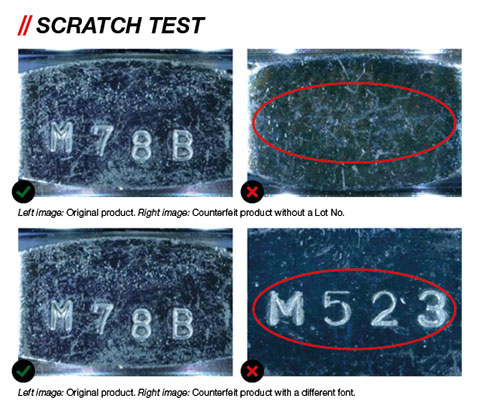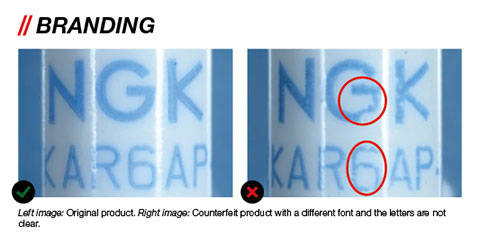Counterfeit spark plugs: The ignition villains that could ruin your engine!

Ignition villains
Knockoff plugs can and most probably will cause serious engine damage. If, for example, the plug overheats and melts, or if a piece of the ceramic insulator breaks off and makes its way into the combustion chamber, the prospect of a catastrophic engine failure is highly likely. Such an extreme outcome will cost the vehicle owner significant amounts in repairs. Things, moreover, could be a lot worse for a workshop that installs such fakes, as they could be leaving themselves open to litigation which could potentially put the company out of business.
Depending on the quality of the imitation, symptoms related to counterfeits such as unusual engine noises and knocking, may appear immediately or over time. This means that if a vehicle owner or a technician somehow becomes aware that they have installed fakes, they should take immediate action and have them removed and substituted with authentic Aftermarket replacements. Sadly, vehicle owners normally only find out when it’s already too late, meaning that the best way to avoid such problems is to take preventative action and ensure that counterfeits never get installed in the first place.
Avoiding counterfeits
- Beware of bargains:
The old adage, “if it sounds too good to be true, it probably is”, is the simplest but perhaps most effective piece of advice to keep in mind when purchasing Aftermarket replacements. Both vehicle owners and technicians should beware of unusually low prices when shopping on e-commerce websites, but also offline, because what may seem like a great deal may in fact turn out to be a terrible one. It is of utmost importance, therefore, that technicians and vehicle owners only buy from authorised distribution channels.
- Inspecting spark plugs:
The variety of counterfeit spark plugs can range from the sublime to the ridiculous, meaning that you have to play extra attention to identify certain types of fakes. The top characteristics to be on the lookout for include:
- Insulator: Fake plugs may display an irregular jagged-shaped insulator that may be made from different ceramics, exhibiting a different colour. Air bubbles trapped inside the insulator are also commonly present. Counterfeits can be spotted using a calliper tool to measure the insulator diameter as well as by carrying out a careful visual inspection of the insulator alongside an authentic spark plug.

- Scratch test:
Knockoff plugs are often coated in a paint that gives the illusion that they are made from high quality metals. A simple scratch test using a sharp object such as a penknife on the hexagon part of the spark plug will reveal the true composition of the spark plug. The hexagon part of a genuine spark plug is never coated in a type of paint that makes it look like it is made from a different type of metal. Moreover, if there is no Lot Number (an identification number assigned to a particular quantity or lot of material from a single manufacturer) or a different type of font used on the hexagon than on a real spark plug, it is a fake.
- Centre electrode:
The centre electrodes of ignition heroes from NGK Ignitions Parts, often made from precious metals, are attached using highly sophisticated welding processes which counterfeiters are incapable of replicating. A close visual check in the presence of a genuine plug may reveal the fake electrode to be either bigger or smaller than the real one, and sloppy looking in comparison. Precious metals like iridium are never found in fakes.

- Ground electrode:
There is generally an obvious difference in appearance between quality of a real ground electrode and a fake. Counterfeiters find it very difficult to replicate the angle of the ground electrode, or the exact gap between the ground and centre electrodes. The correct distance between the electrodes will be included in the NGK Ignition Parts specifications and can be measured using a coin-style spark plug gauge or a feeler gauge.

- Crimping portion:
Take a close look at the crimping portion of the plug. If you can see a machine cutting mark on it, be alert; this is indicative of a fake product.

- C-Groove portion:
If there is a machine cutting mark on the surface of the metal shell on the C-Groove portion, this is another indicator of a counterfeit.

- Branding:
Have a look at the product name on the spark plug, which should be accurately printed. If the font type is smudged in some way, it might be a counterfeit.
To conclude, always buy from authorised distributors, be especially cautious with unusually low-priced spark plugs and pay close attention to the spark plugs themselves. If you have any suspicions regarding a particular spark plug, do not hesitate to contact a trusted workshop who will be able to verify its authenticity.
